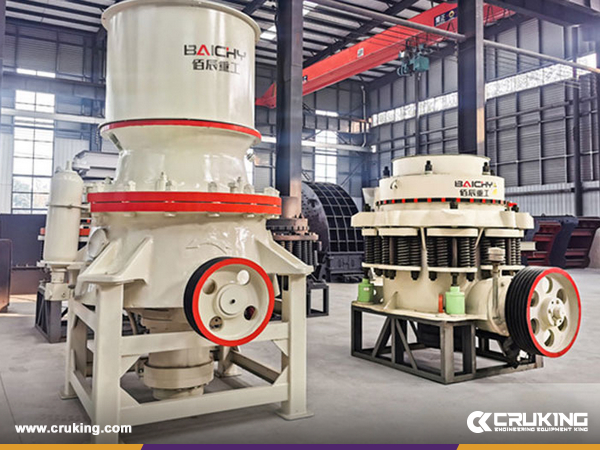Gyratory
crusher and cone crusher, as two important pieces of equipment in the crushing industry,
each play an indispensable role in the crushing operation. So, what is the
difference between these two types of crushers? How to choose between them in
practical application? Below, we will analyze in detail from five aspects for
you.
1.
The differences in the way of cone suspension
The
lower end of the crusher's cone is supported on the base, and the upper end is
fixed in the shaft sleeve in the middle of the crossbeam of the upper frame.
This design makes the cone crusher more stable in operation, which is suitable
for scenes with high requirements for crushing efficiency. On the other hand,
the dynamic cone of the gyratory crusher is suspended on the crossbeam of the
frame, and this structure gives the gyratory crusher a larger crushing force
and crushing range, which is especially suitable for dealing with large
materials.

2.
Comparison of crushing chamber structure
The
crushing cavity of the cone crusher is a gently inclined positive truncated
cone with a parallel crushing area in the lower part, which makes the material
more fully crushed in the crushing cavity. The gyratory crusher has a sharply
inclined crushing chamber with a positively positioned dynamic cone and an
inverted truncated cone. This design makes the gyratory crusher have higher
crushing efficiency and lower energy consumption when dealing with large
materials.
3.
The difference in discharge opening adjustment
Cone
crusher usually adopts single-cylinder hydraulic adjustment, through the
hydraulic cylinder to promote the main shaft and cone rising or falling, to realize
the adjustment of discharge opening. This adjustment method is convenient and
quick, and the adjustment range is large. On the other hand, the gyratory
crusher utilizes the lifting and lowering of the moving cone to adjust the
width of the discharge opening, which is relatively simple but has a smaller
adjustment range.
4.
The difference in application scenarios
Because
of its high efficiency and stability, the cone crusher is more suitable for medium
and fine crushing operations, especially in the handling of hard materials with
outstanding performance. The gyratory crusher is known for its large crushing
force and high crushing range, more suitable for coarse crushing operations,
especially when dealing with large materials with obvious advantages.
5.
Selection of dustproof device
In
terms of dustproof devices, cone crusher usually adopts water seal dustproof
devices, through the water seal will be dust and external environment isolation,
to achieve the effect of dustproof. On the other hand, gyratory crushers
usually adopt dry dustproof device, which reduces dust emissions by optimizing
structural design and sealing measures. When choosing, users can choose
according to the actual needs and site environment.

Through
the above comparison, we can see that gyratory crushers and cone crushers have
their advantages and disadvantages, and the choice of equipment
depends on the actual needs and application scenarios. In large-scale mines and
coarse crushing operations, gyratory crushers dominate with their large
crushing force and high crushing range; while in medium and small-sized gravel
plants and construction sites and other medium and fine crushing operations,
cone crushers are favored for their high efficiency and stable performance.
Therefore, when choosing a crusher, users should fully consider their own needs
and site environment, and choose the most suitable equipment for themselves.
2021-06-27
2021-09-30
2021-01-13
2021-01-14
2021-12-31
2021-08-10
2021-12-14
2021-01-15